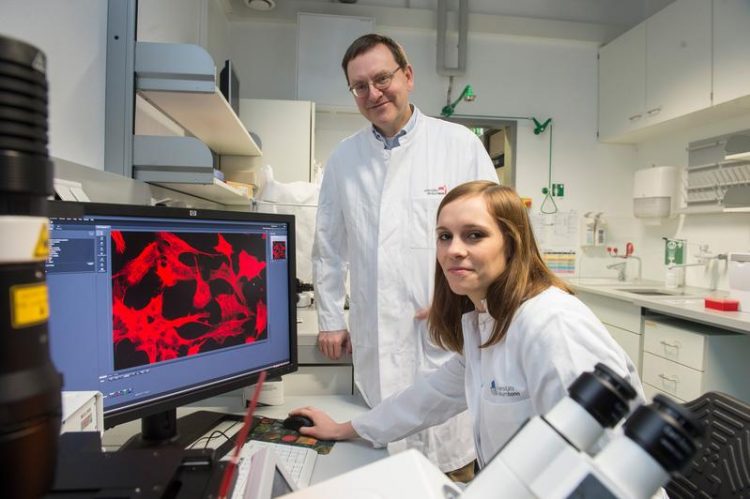Researchers at the University of Bonn boost fat-burning

In the lab: Prof. Dr. Alexander Pfeifer and Katarina Klepac from the Institute of Pharmacology and Toxicology at University of Bonn. © Photo: Barbara Frommann/Uni Bonn
Significantly overweight people have a particularly large number of white fat cells but in contrast, they lack brown fat cells. The white cells are responsible for bothersome fat deposits; conversely, the brown cells “burn off” unwanted pounds by releasing the energy stored in them in the form of heat.
Prof. Dr. Alexander Pfeifer from the Institute of Pharmacology and Toxicology at the University of Bonn has spent years researching how harmful white fat cells can be converted into desirable brown fat cells.
“We are looking for targets for new pharmaceutical products to one day be able to effectively combat obesity as the cause of numerous widespread diseases, such as diabetes or cardiovascular disease,” says the scientist. If the researchers' dream comes true, brown fat cells could be boosted with yet-to-be-developed active substances such that rolls of fat could simply be melted off. “However, we still have a long way to go,” says Prof. Pfeifer. His studies are still in the basic research stage.
There is a particularly high number of Gq proteins in brown fat cells
An international team of scientists working with Prof. Pfeifer, under the leadership of the University of Bonn, with colleagues from San Diego and Bethesda (both USA), Gothenburg (Sweden) and the Universities of Heidelberg and Leipzig, has discovered a “switch” in the fat cells of mice which can be used to accelerate fat burning. The researchers observed that there is a particularly high number of receptors in brown fat cells which bind to the Gq protein. The Gq protein performs an important function in information transfer.
The scientists activated the Gq protein in the mouse fat cells and as a result, the number and quality of the brown cells decreased. “On the other hand, if Gq is blocked with an inhibitor, more brown fat cells mature,” says Ph.D. student Katarina Klepac from Prof. Pfeifer's team. The same applies to the beige fat cells on which the researchers are pinning their hopes. They can convert from white to brown fat cells and are also involved in “burning” excess energy stores. If the Gq protein is blocked in them, more brown “fat burners” form.
The conversion also works for human fat cells
Does the inhibition of the Gq proteins only work in mouse cells or also in human fat cells? The team of researchers conducted the experiments – which had previously been performed on rodent cells – also on human cells which they cultured in the laboratory. “Even in human fat cells, it was shown that brown fat cells can grow much better once Gq proteins were blocked,” says Prof. Pfeifer.
According to the researcher, this could be a highly promising potential starting point for the development of active substances which boost fat burning in obese patients. “To date, there are no drugs which directly cause white fat cells to convert into brown fat cells,” says Prof. Pfeifer. It will still be some time until suitable active substances are available on the market.
Publication: The Gq signalling pathway inhibits brown and beige adipose tissue, Nature Communications, DOI: 10.1038/NCOMMS10895
Media contact information:
Prof. Dr. Alexander Pfeifer
Institute of Pharmacology and Toxicology
University of Bonn
Tel. ++49-228-28751300
E-Mail: alexander.pfeifer@uni-bonn.de
http://www.nature.com/naturecommunications Publication online
Media Contact
More Information:
http://www.uni-bonn.de/All latest news from the category: Health and Medicine
This subject area encompasses research and studies in the field of human medicine.
Among the wide-ranging list of topics covered here are anesthesiology, anatomy, surgery, human genetics, hygiene and environmental medicine, internal medicine, neurology, pharmacology, physiology, urology and dental medicine.
Newest articles

Webb captures top of iconic horsehead nebula in unprecedented detail
NASA’s James Webb Space Telescope has captured the sharpest infrared images to date of a zoomed-in portion of one of the most distinctive objects in our skies, the Horsehead Nebula….

Cost-effective, high-capacity, and cyclable lithium-ion battery cathodes
Charge-recharge cycling of lithium-superrich iron oxide, a cost-effective and high-capacity cathode for new-generation lithium-ion batteries, can be greatly improved by doping with readily available mineral elements. The energy capacity and…

Novel genetic plant regeneration approach
…without the application of phytohormones. Researchers develop a novel plant regeneration approach by modulating the expression of genes that control plant cell differentiation. For ages now, plants have been the…





















